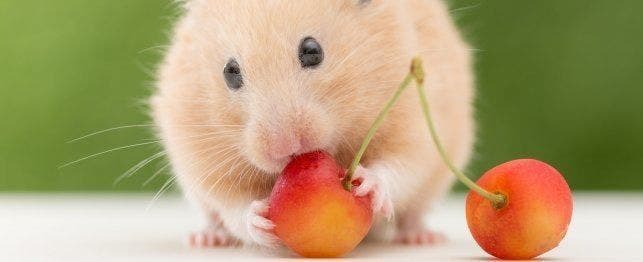
Choosing a Golden Hamster
Whether you think of your golden hamster as an Olympic endurance athlete or as a Sleeping Beauty of sorts, there are a few things you should know about his care and natural history to create the best possible living environment for your pet.
All domestic golden hamsters are descendants from a single litter discovered in Syria in 1930. A traveling zoologist unearthed the litter in its burrow and transported three of the hamsters to Europe in captivity. Their offspring were first brought to the United States in 1938 as laboratory research animals; soon they became popular pets. More than 1 million hamsters are now used in laboratory research each year, making them the third most popular experimental subjects following mice and rats.
Appearance and Behavior
The most common pet hamster is the Syrian or golden hamster. Syrian hamsters typically have reddish-gold hair that lies flat and smooth against their small compact bodies. You can find hamsters with a wide range of coat lengths and alternative colors ranging from albino to a deep black-brown.
Most hamsters are docile unless surprised or disturbed during their 14-hours-a-day sleep cycle. If you do wake a sleeping hamster, you can expect a sharp bite from his ever-growing incisor teeth.
Feeding
A pet hamster’s diet should consist mainly of grains and seeds, though they enjoy and need more fresh vegetables than most other rodents. A hamster’s stomach has two compartments to facilitate the digestion of tough foods. The first compartment is a fermentation chamber similar to a cow’s stomach. Despite their complex plumbing arrangements, hamsters may need to eat their own feces as a means of double-digesting their food to process it completely. This practice is not unique to hamsters; guinea pigs do the same thing.
Housing
Your pet is a solitary creature and needs to live by himself. A golden hamster cage should be no smaller than one foot square, but your hamster will be much happier in a cage twice that size. He needs room to exercise, a thick layer of shavings as bedding on his cage floor, and a quiet place to sleep away the day.
Special Concerns
Loners in the wild, hamsters often meet up with other members of their species only to mate and then part ways. As such, hamsters are disinclined to form permanent attachments to others. You will find your pet to be a solitary creature and should not try to house him with other hamsters. When you are ready to start handling your hamster, remember that he has relatively poor eyesight and relies heavily on his sense of smell to identify other animals. Never sneak up on him or approach him with fingers that smell like food.
A pet hamster needs the same things that his wild cousins do: lots of exercise, available food and fresh water, and a safe and secure place to sleep away the majority of the day. He will be happiest if you give him his space and allow him to rest on his schedule rather than yours.